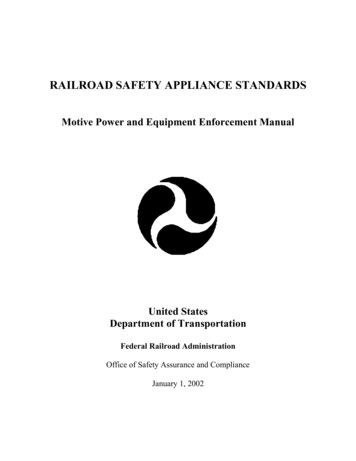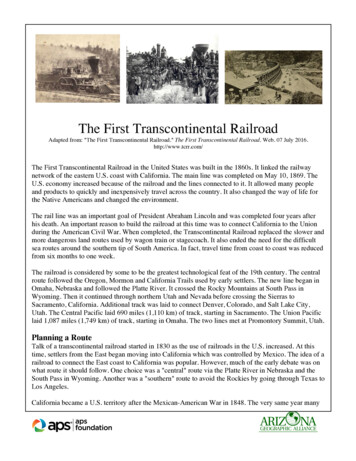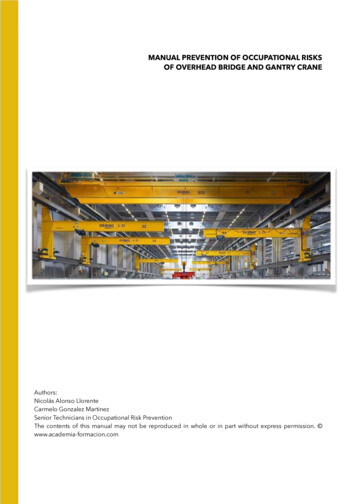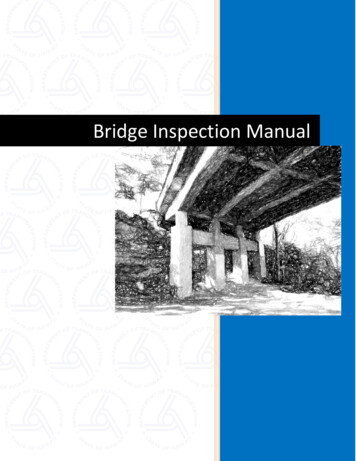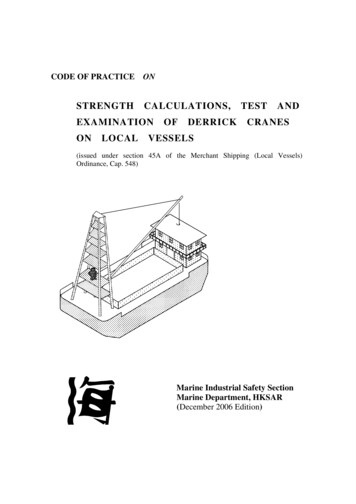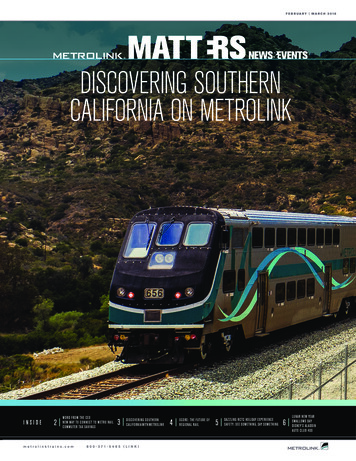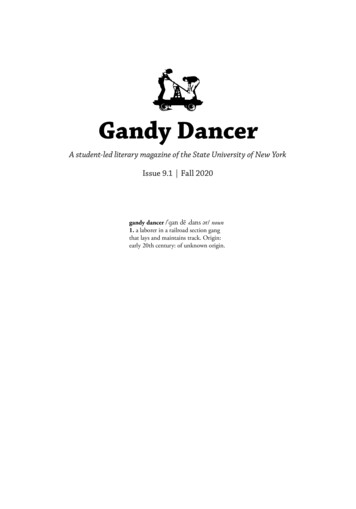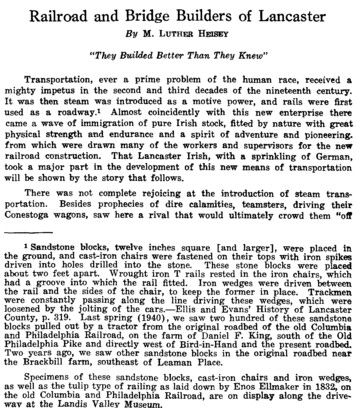
Transcription
Railroad and Bridge Builders of LancasterBy M. LUTHER HEISEY"They Builded Better Than They Knew"Transportation, ever a prime problem of the human race, received amighty impetus in the second and third decades of the nineteenth century.It was then steam was introduced as a motive power, and rails were firstused as a roadway. 1 Almost coincidently with this new enterprise therecame a wave of immigration of pure Irish stock, fitted by nature with greatphysical strength and endurance and a spirit of adventure and pioneering.from which were drawn many of the workers and supervisors for the newrailroad construction. That Lancaster Irish, with a sprinkling of German,took a major part in the development of this new means of transportationwill be shown by the story that follows.There was not complete rejoicing at the introduction of steam transportation. Besides prophecies of dire calamities, teamsters, driving theirConestoga wagons, saw here a rival that would ultimately crowd them "off1 Sandstone blocks, twelve inches square [and larger], were placed inthe ground, and cast-iron chairs were fastened on their tops with iron spikesdriven into holes drilled into the stone. These stone blocks were placedabout two feet apart. Wrought iron T rails rested in the iron chairs, whichhad a groove into which the rail fitted. Iron wedges were driven betweenthe rail and the sides of the chair, to keep the former in place. Trackmenwere constantly passing along the line driving these wedges, which wereloosened by the jolting of the cars.—Ellis and Evans' History of LancasterCounty, p. 319. Last spring (1940), we saw two hundred of these sandstoneblocks pulled out by a tractor from the original roadbed of the old Columbiaand Philadelphia Railroad, on the farm of Daniel F. King, south of the OldPhiladelphia Pike and directly west of Bird-in-Hand and the present roadbed.Two years ago, we saw other sandstone blocks in the original roadbed nearthe Brackbill farm, southeast of Leaman Place.Specimens of these sandstone blocks, cast-iron chairs and iron wedges,as well as the tulip type of railing as laid down by Enos Elimaker in 1832, onthe old Columbia and Philadelphia Railroad, are on display along the drivewa y at the Landis Valley Museum.
the road." The exchange of words of the teamsters with the Irish andScotch-Irish, who could "clothe themselves with curses as with a garment,"was none too refined. We print some verses from the "Wagoner's Curse onthe Railroad," to show the plaint of the teamsters.The ships, they'll come in with Irishmen by loads,With their picks and their shovels, to work on the railroads.When they get on the railroad, it's then they are fixed,They'll fight like the devil with their cudgels and their sticks.The American with safety can scarcely ever pass,For they'll black both his eyes for one word of his "sass."If it was not for the torment, I'd as leave be in hell,As upon the railroad, or upon the canal.Now all ye jolly wagoners who have good wives,Go home to your farms and there spend your lives;When your corn is all cribbed and your small grain is sowed,You'll have nothing to do but curse the railroad. 2Now to go on with the story of the builders, Irish and non-Irish, ofLancaster city and county, showing what and where they built.Among the very pioneers of railroad building was the capable localcivil engineer and surveyor, JOSHUA SCOTT, who planned the State Roadthrough and west of Lancaster in 1833. Many early Lancaster County mapsand surveys were drawn by him, one being presented with the complimentsof the author to Lafayette, on his visit here in 1825.THOMAS BAUMGARDNER was born in York, Pa., of German parentage,December 20, 1816. Besides his interest in railroad work, his business activities were wide and varied. He was a director of the Philadelphia andSunbury, and the Reading and Columbia railroads. He obtained a charterfrom the State Legislature, and built the Enterprise Railroad in 1868, whichin a short time he sold to the Reading Company. In 1869, he built the Junction and Breakwater Line in Delaware.WILLIAM H. BROWN was born in Little Britain Township on February29, 1836, son of Levi K. Brown, and grandson of Jeremiah Brown, whorepresented Lancaster County in Congress from 1840 to 1844 (see Vol. 34,p. 55).At the age of twenty-five years, "Billy" Brown, as he was called then,engaged in his first work on railroads—trial surveys on the Lancaster, Oxford and Southern Road, in the neighborhood of his home.He was selected by Colonel Thomas A. Scott as engineer of the UnitedStates military railroads in Northern Virginia, with headquarters atAlexandria. In October, 1861, he was transferred to the Pittsburgh Division, Pennsylvania Railroad, where he remained until March 17, 1865, whenhe was appointed engineer of the Oil Creek Railroad. In July, 1865, he2 The poem in full appears in "The Conestoga Six-Horse Bell Teams ofEastern Pennsylvania," by John Omwake, 1930, p. 122.
accepted the position of principal assistant engineer and in September,1865, was appointed engineer of the Philadelphia and Erie Railroad. Heassisted in the completion of the Pan Handle Road. In June 1, 1881, hewas appointed chief engineer of the Pennsylvania Railroad, and so continued until his retirement on February 28, 1906, having reached the age ofseventy years. While serving in this latter position he practically rebuiltthe Pennsylvania Line from Pittsburgh to Philadelphia.The Rockville bridge, spanning the Susquehanna River above Harrisburg, was planned and built by Mr. Brown in 1900-1902. It is the largeststone arch bridge in the world, being 3,830 feet in length, with 48 arches,52 feet in width, and is a four-track structure. His assistant in the bridgeconstruction, George Nauman, was also a Lancastrian.ENOS EllMAKER (1800-1885), born in Earl Township, Lancaster County,laid the first tulip or edge railing on the new Columbia and Philadelphia Railroad in 1832 from Philadelphia to Paoli. Concerning this he wrote: "Whenthe first shipload of railing came across from England, Major [John] Wilson,head engineer, made inquiry of Mr. Provost where he could find a man competent to start or commence the laying of the rails. Mr. Provost recommendedme. Major Wilson then gave me plots and plans of the Liverpool and Manchester Railroad to examine for a fortnight. After studying the plans, I madetools. Then I took five men with me and we laid rails five days, and succeededto a demonstration of railroad building." 3 After this work, Mr. Ellmakertook a contract for sixteen turnouts.In 1836 he migrated to Iowa Territory. In 1853 he moved to Oregon, andthere he died in 1885, in his eighty-fifth year.JOHN J. FITZPATRICK (b. in Lancaster, October 10, 1840, d. December 14,1889), son of Hugh Fitzpatrick, both contractors, assisted Richard McGrannon work on the North Pennsylvania Railroad and on the Chestnut Streetbridge in Philadelphia. He completed a contract for the Boundbrook Road, andworked with Bernard J. McGrann on the Pittsburgh and Lake Erie Line, andwith John and Edward McGovern on the South Penn Railroad near Somerset.He worked on the Shenandoah Valley Railroad, and laid an extra track forthe Pennsylvania Line at Highspire.GEORGE F. Goll was born in Germany, May 21, 1832. When a young man,he came to this country, and in 1875 with John Keller engaged in railroadcontracting and bridge building, devoting most of his time and skill to thelatter work. Among the staunch and enduring structures built by him were the"Big Bridge" over the Conestoga River, several about Johnstown, the Cumberland Valley Railroad bridge over the Susquehanna at Harrisburg, another forthe same company over the Potomac, and three on the Pittsburgh Division atSummer Hill, one over the Juniata River at Tyrone, and several in New YorkState. Mr. Goll died Sunday, February 15, 1891, and the contracting work was3 For further information concerning the Ellmakers, see the PennsylvaniaGerman magazine, Vol. 10, p. 345.
carried on by his sons, John A., William H. and George F., under the firmname of John Goll & Co. They did extensive remodeling to the stations atHarrisburg and Philadelphia, on the Pennsylvania Line, and completed severalbridges on the Cumberland Valley Road.JOHN H. HOOK, of German descent, son of John and Catherine Klaus Hook,was born in Lancaster, April 5, 1858. Leaving school when thirteen years ofage, he started at the bottom round as water boy in 1871, and kept climbinguntil 1898 when he retired as a successful railroad contractor. From 1884 to1889 he was master stonemason for the Frederick Division of the PennsylvaniaRailroad Company; in October, 1889, he associated with J. Frank Keller. Forthe Pennsylvania Line, he constructed a bridge over the Juniata River nearAltoona, Pa., containing 10,700 cubic yards of masonry, and costing 107,000;a bridge over Stone Creek at Huntingdon, Pa., containing 4,000 cubic yardsof masonry, and one over Shaver's Creek at Petersburg, Huntingdon County,Pa., containing 3,500 yards of masonry.JOHN FREDERICK HOUSTON, of Scotch-Irish ancestry, son of William F.and Amy McCorkle Houston, was born in Columbia, and there spent most ofhis days. His biographer said, "he was one of the brightest young men of ourcountry," and was graduated from Amherst College with high honor. Qualifiedas a civil engineer, he was engaged in the construction of the Baltimore andSusquehanna Railroad, running from Wrightsville to York, which was completed in 1839; the Gettysburg Line; and State works of Pennsylvania inprogress between 1834 and 1839. Later he studied law, practicing in the countiesof Lancaster and York. But the promise of an active and brilliant career wasfrustrated by an attack of paralysis when he was but thirty-five years of age.The Wrightsville, York and Gettysburg Railroad, noted above, came intopossession of the Pennsylvania Railroad on June 21, 1870.JOHN KEllER was born near Elizabethtown, September 19, 1828, of Germanparentage. From early youth he was employed in railroad work. In 1868 heengaged in contracting and quarrying, and several years later in bridge building and general railroad contracting. In 1875 he constructed the Lancasterand Quarryville Railroad; later he built thirteen miles of the Schuylkill ValleyRoad; the Harrisburg and Gettysburg Line; one hundred and eleven miles ofthe New York, Philadelphia and Norfolk; the Pennsylvania and Northwesternfrom Irvona to a point four miles beyond Punxsutawney; a branch of theHarrisburg and Potomac; the Cambria and Clearfield; thirteen miles of trackbetween Glenlock and Trenton; and the western part of the Philadelphia andFort Washington Railroad.He was among the first to project the idea of the Conewago and CornwallRailroad, of which he made the first survey, and also of the road between Lancaster and New Holland. On the New York, Philadelphia and Norfolk Road in1884, he constructed seventy miles in eleven months. A stretch of seven mileswas completed in one week, and a day after the work was finished a locomotivepassed over it in seven minutes. Mr. Keller was then employing fourteenhundred men.
At the time of the construction of the buildings for the Centennial Exhibition in Philadelphia in 1876, he had the contract to lay all tracks into thebuildings. In Kansas he helped to construct the Fort Scott and Topeka line,of which he became president, and which was later sold to Jay Gould. Kelleralso worked for Mr. Gould on one hundred and twelve miles of road fromMemphis, Tennessee, to Bald Knob, Arkansas.The name of Keller was given to a railroad station and post office inAccomac County, Virginia, in honor of the contractor, who was then workingon the New York, Philadelphia and Norfolk Road. The post office was established in a general store, December 15, 1884, with William S. Murphy thefirst postmaster.J. FRANKLIN KEllER (b. February 8, 1858, d. March 23, 1935), was associated with his father, John Keller, in the contracting business, later working with John H. Hook.HUGH KEOGH was born in Western Pennsylvania, at Port Perry, in February, 1847. He became associated with Bernard J. McGrann in constructionwork on the Pittsburgh and Lake Erie Railroad, later building the MaderiaRoad, and constructing two hundred miles of track in Brazil. Near Bandywine, Delaware, he built two miles of track for the Baltimore and Ohio System,and then worked in Somerset County for the Southern Pennsylvania Railroad(South Penn Road). This company later abandoned the entire work, and itsroadbed and tunnels now serve as the route of the "dream" or super-highwayrunning across Pennsylvania from Middlesex to Irwin, a distance of one hundred and sixty miles. He also built a stretch of track from Delano to Hazletonfor the Lehigh Valley Road, and was at one time manager of the constructiondepartment of the Shenandoah Valley Line.Two miles of heavy work on the old "Tape-worm" Railroad, one of Thaddeus Stevens' projects, between Gettysburg and Hagerstown, was constructedby him, and also a portion of the railroad which was destroyed by the Johnstown flood in 1889. Following this, he built the fourth track for the Pennsylvania Railroad from Wilmore to Portage; a portion of track running throughthe Allegheny Mountains at Horseshoe Curve; ten miles of the Norfolk andWestern Railroad; and a track from Fernwood to Newtown Square.BERNARD E. MALONE, son of the late Major James and Alice McGrannMalone, was born in County Cavan, Ireland, in 1844, and died July 8, 1915. Inearly manhood he embarked in the contracting business. He built the JerseyCity and Pine Creek Railroad, and a part of the Norfolk and Western Line,from Roanoke to Salem in Virginia.RICHARD A. MALONE was born in County Cavan, Ireland, March 5, 1834,and came with his parents to America in 1845. The next year they removed toLancaster where the father, James, engaged in the business of contracting andbuilding. Richard, associated with David McNeely Stauffer, constructed theDorchester, Massachusetts, bay tunnel, a great feat of engineering skill. Hebuilt many bridges, tunnels and miles of railroad, some for the Vanderbilt lines.A son, Charles, engaged in business with his father; another son, Richard J.,
became a railroad contractor in Philadelphia; another, John E., is a prominentLancaster lawyer and former postmaster. Died March 2, 1909.PATRICK McEvoy (1805-1870), following the Irish tradition, got his startin life by working on the railroad. As a contractor, he worked on the Penn-sylvania Central Railroad, the New York and Erie, on the Susquehanna Tidewater Canal, and in New Jersey. When traveling on the Pennsylvania Railroad about Kittanning Point and enjoying the scenic beauty at the HorseshoeCurve, every true Lancastrian will remind his fellow-travelers that it was alocal man—Patrick McEvoy—who built this road, which was considered amarvelous piece of engineering skill in its day. His last contract was withthe Philadelphia and Erie Railroad, for constructing Bennett's Branch, eighteenmiles in length, at Driftwood. It was on this branch that Mr. McEvoy'snephew, James Timothy Dunn, succeeded him as superintendent; the latterhaving gained experience on railroads in New Jersey with another uncle,Patrick Maher. Another member of the latter family, Daniel Maher, brotherof Patrick, assisted Patrick McEvoy and James Purcell in building the IndianaBranch of the Pennsylvania Railroad in 1854-55.Mr. McEvoy was one of the founders of the Buchanan-McEvoy-ReynoldsRelief Fund for the needy of Lancaster City.LETTERS OF RECOMMENDATIONWe record the following letters of recommendation to show the high esteemin which Patrick McEvoy was held in his community.Lancaster, Penna.April 11/57My dear SirI take the liberty, and I do so with much pleasure, knowing your character for politeness and attention to yourfriends, of making known, to you, P. McEvoy, Esq., of Lancaster County, who will present this letter to you.Mr. McEvoy intends, possibly, to bid on the Gov't workto be allotted by you at Washington City; and it affords megreat satisfaction to say of him that he is a gentleman ofmerit, an honest and most efficient contractor of great experience, who has carried out very heavy contracts on publicworks in different sections of the country, with satisfactionto all parties interested. He is a man of property; his wordis as good as his bond, and I hesitate not one moment inpronouncing and endorsing him a man in every respectworthy of your confidence.Mr. McEvoy is the immediate neighbor of our newPresident, and not only with Mr. Buchanan, but with allclasses of his fellow-citizens, stands deservedly high for hisupright character, for integrity and honor. No man of myacquaintance is more worthy of it; and as such I recommendhim to your kind attention and favorable consideration.
Should Mr. McEvoy be so fortunate as to meet withsuccess as a bidder, you will have a contractor who willrender complete satisfaction.I am, by dear Sir,As Ever, Very decidedly Yr. Friend & m't Ob't St.[signed] SAML. HUMES PORTER.ToCapt. M. C. Meigs,U. S. Engr. Corps,Washington City,D. C.Office of theGreenwich Improvement and Rail Road Company,No. 28 Merchants Exchange,Philad'a., April 14, 1857.Capt. M. C. Meigs,Dr. SirAllow me to introduce P. McEvoy, Esq., of Lancaster,Pa., a near neighbor and friend of President Buchanan, acontractor of 20 years experience, a gentleman of large meansand sterling integrity. I am perfectly sincere in saying thatI have never known a more reliable man, a more efficientenergetic contractor or one in whose performance of engagements more confidence can be placed. Mr. McEvoy will nottake work at less than remunerative prices but what he doesundertake will be complied with to the letter.Yours very truly,[signed] H. HAurr. 5P. S. I forgot to state that Mr. M. has done more workon the Penna. R. R. and heavier work than any other contractor, so that I speak from personal knowledge. His masonwork has been particularly well executed.—H. H.COLONEL EDWARD McGovERN, of Irish descent, was born in Lebanon, Pa.,November 11, 1834, and was educated at Holy Cross and Georgetown colleges,receiving the degree of A. M. from the latter. After service in the Civil War,he went to Mexico where he worked as civil engineer for the Vera Cruz Railroad Company for three years. Returning to New Orleans, he secured employment for two years on the Louisville Short Line Railroad; later he workedfor the Pittsburgh and Connellsville Railroad, superintending the constructionof two large tunnels. Coming closer to home, we find him employed as a contractor on the Columbia and Port Deposit Railroad. After working a short4 Samuel Humes Porter, well known Lancaster lawyer who was admittedto the bar in 1840, was the son of George B. Porter, Esq., and the grandson ofGeneral Andrew Porter and Samuel Humes.5 Herman Haupt was of a family of famous civil engineers, and was thegreat-uncle of the popular local Lutheran preacher, the late Rev. C. ElvinHaupt, D. D. (See National Cyclopedia, Vol. 10, p. 224).The above letters are in possession of Miss Elizabeth J. D. Lant, a relativeby marriage of the late Patrick McEvoy. She also has an interesting collection of photographs of the construction work on Bennett's Branch.
time in New Jersey, he went to Colorado in 1880, finding employment with theDenver and Rio Grande Railroad Company. Here he achieved the feat oftunneling the Cascade Mountains. When he again returned to his Lancasterhome, he engaged in farming and fruit growing.Died September 19, 1897.JOHN R. McGOVERN, was born in County Cavan, Ireland, in 1816, and diedSeptember 25, 1882, at his home at the extreme end of North Duke Street,where now the Pennsylvania Railroad depot is located. He was another immigrant who rose by his own efforts to a successful career as a contractor.He, with Andrew Reilly, constructed a portion of the New York and Lake ErieRailroad for Richard McGrann. He superintended the construction of thetunnel at Columbia, and with Bernard J. McGrann and John Reilly contractedfor and completed a part of the Pennsylvania Central Railroad from Altoonato Pittsburgh. With Hugh Barr, of Philadelphia, he built a section of theLebanon Valley Road, a contract taking three years for completion. He alsohad a part in the construction of the East Penn Railroad from Allentown toReading.He worked with Major William M. Wiley on a contract for the NorthernRoad in Dauphin County, and built that part of the Reading and ColumbiaRoad from Reading to Silver Spring, and with Michael Reilly built that portion of the road from Lancaster to Manheim, and also the Sunbury andLewistown Railroad, extending from Lewistown to Selinsgrove, a distance offorty-four miles. In 1876, he worked on the Union Central in SchuylkillCounty.THOMAS MCGOVERN, of McGovernville, and later of 612 North Duke Street,Lancaster, was a contractor who built many miles of railroad in this state.He died January 5, 1882, in his seventy-seventh year. Two daughters marriedcontractors; Catherine J. to John R. McGovern, Anna M. to Michael Reilly.Irish grit, with Irish will and energy, came to the shores of America in1819 with RICHARD MCGRANN, who, then almost penniless, made his dreams ofAmerican opportunity come true, and by a life of industry and clevernessgained fame and fortune. He was one of the first Irishman to be attracted torailroad work, starting on the pioneer State Railroad between Columbia andPhiladelphia; then doing work on the Lehigh, Raritan, Union and Wellandcanals; portions of the Erie Railroad and the main line of the PennsylvaniaRailroad; and, with other contractors, nearly the whole of the North Pennsylvania Railroad. He died October 14, 1867, while constructing the Lehigh andSusquehanna Railroad, with the bridge crossing the Delaware and Lehighrivers at Easton, Pa.At the time of his death the Philadelphia Press said: "Richard McGrannwas well known in Pennsylvania as one of the most enterprising and courageous contractors in the state. The elegant bridge which spans the Schuylkillat the end of Chestnut Street, Philadelphia, is a lasting and most creditablemonument of his labor; the Pennsylvania and Northern Central railroads, aswell as many other lines, testify to his success."
Mr. McGrann settled in Manheim Township in 1835, and three years laterbuilt his splendid mansion on the estate which became known as "Grand View."Modern city and suburban homes now cover the land once known as McGrann'sPark and Grand View Farm. Where stood the old mansion—until its demolition in 1939—with its spacious lawn and beautiful trees and marble statuary,now stands an immense apartment house, retaining nothing of the old exceptthe name alone—"Grand View" Apartments.BERNARD J. MCGRANN, son of the above, was born at Grand View on June24, 1837. He followed in his father's footsteps in many enterprises, especiallyas farmer, banker and railroad contractor. In 1870 he built the Catawissaextension from Milton to Williamsport, and later graded a part of the Boundbrook Road from Jenkintown to Yardley, including the bridge at the latterplace spanning the Delaware River. His crowning achievement was the construction of the Pittsburgh and Erie Railroad from Pittsburgh to Youngstown, Ohio, a distance of some seventy miles, which was completed accordingto contract in one year. The bridge he built over the Ohio River at Beaver,Pa., had a heighth of 95 feet above the water to admit of proper navigation,and had a channel span of 446 feet, with long approaches of iron frame work.When the Lancaster County Fair Association failed, Mr. McGrann tookover their property, and conducted successful fairs, and upon the half miletrack adjoining were held exciting horse races.Contrary to the impression held by the writer, McGrann post office,established in 1906, in Armstrong County, was not named for Bernard J.McGrann, but for Philip R. McGrann, the postmaster, no relative of Bernard.RICHARD J. MCGRANN, a cousin of Bernard J. McGrann, was born in NewYork City in 1837, and died at his Prince Street home in Lancaster, September2, 1907. He, with several partners, completed the Downingtown and Waynesburg (Honeybrook) Railroad, the New Castle and Beaver Valley Road, theheaviest work on the line through the Wyoming Valley, which first broughta railroad into Wilkes-Barre, and did some work between White Haven andMauch Chunk, and assisted in the building of the Chestnut Street bridge inPhiladelphia. He also built many miles of road in mountainous sections forthe Reading System, forty miles in the Shenandoah Valley, a section of theNorfolk and Western with many large bridges, and a part of the Louisvilleand Nashville Line. He built twenty-five miles of road in Clinch Valley, Virginia, a connection between the Lynchburg and Durham Line and the Norfolkand Western, and the Cripple Creek and Pocohontas extension; his last workwas a section of seven miles on the Speedwell extension.The eighteen-mile stretch of track of the Hanover and York Railroad waslaid in 1873 by REHIll AND MCTAGUE, contractors, the latter of Columbia, Pa.This firm also worked on sections 12 and 13 of the Bennett's Branch extensionof the Allegheny Valley Railroad.Peter S. MCTAGUE, with a son, Harry P. (d. January, 1910,) did contracting work in Western Pennsylvania and New Jersey. Peter McTaguedied March 8, 1910, aged eighty-five years.
Among the young civil engineers in the early days of railroad buildingwas SAMUEL W. MIFFLIN, of the famous family in Columbia, Pa. He was employed by the larger railroad companies in Pennsylvania, New York, NewJersey and the New England states. "He located a considerable mileage of thedifficult mountain division of the Pennsylvania Railroad, and was regarded asone of the greatest locating civil engineers of the country; his minor workcovered a large area of our own country," writes Samuel Wright.WIllIAM PATTON was born in County Tyrone, Ireland, in 1817. In thatyear his father brought the family to America, first settling in Chester County,and in 1850 removing to Columbia, Pa. After engaging in various mercantilepursuits, he turned his attention to contracting. He built the round-house atColumbia for the State Railroad. He constructed the greater portion of theHuntingdon and Broad Top Railroad, including the famous Stonerstown bridgewhich spanned the Raystown branch of the Juniata River near Saxton. Thisbridge was two thousand feet in length, built of wood and masonry, and was aremarkable piece of work in its time. In 1865 Mr. Patton finished his careeras a railroad builder, and turned to other enterprises. He held many important positions in the civic and church life of his home town, Columbia.JOHN REIllY, of the firm of Reilly and McGrann, was associated withRichard McGrann in many important contracts. They built the ChestnutStreet bridge over the Schuylkill in Philadelphia, the Lehigh and SusquehannaLine and the North Pennsylvania Road. Mr. Reilly also built the LachineCanal near Montreal, Canada, and the Easton and Amboy Railroad. Hiseldest son, JOHN B., became a railroad and bridge builder, and resided in NewYork City. Another son, T. WALLACE, went into the same business about 1880,doing work for the Lackawanna Road in New York State and building bridgesfor the Pennsylvania Line at Glenloch, Middletown and other points; he alsoerected bridges at Providence and Woonsocket, Rhode Island, besides somesewerage and street grading work in New York City. The Reillys werefurther joined to the railroad business when another son, Richard M., marriedMary Barry, whose grandfather, Michael Barry, was one of the pioneers inthe business in this part of the state.JOHN M. BARRY, son of Michael, was a sub-contractor under Bernard J.McGrann in the building of the notable Allegheny Valley Road, and under contract with his brother-in-law, John J. Fitzpatrick, helped to build the SouthernPennsylvania Road. He died at his home on East Orange Street, Sunday, May9, 1886.MICHAEL REILLY was born in County Meath, Ireland, January 30, 1833,the son of John and Mary Smith Reilly. Coming to America when ten yearsof age, he soon found work on the railroads, and by the time he was nineteenyears of age he was a competent contractor. He associated with John Kellerand others, and for a period of over forty years did efficient building and contracting, retiring in 1892.Mr. Reilly built many of the trolley lines in Lancaster. His railroad workincluded the Reading and Columbia, the East Pennsylvania Road between
Allentown and Reading, and many other lines, besides tunnels, bridges andgrading of all kinds. Reilly and Keller built the Quarryville Line, which wasleased to the Reading Company, and later sold to the Pennsylvania Road(1915).In 1851, Mr. Reilly was married to Anna, daughter of Thomas and MaryDuffy McGovern, natives of County Cavan, Ireland. This Thomas McGovernalso was a builder of railroads and canals. Mrs. Reilly was first married toJohn McManus, and their second child, Thomas, was a railroad contractor, andresided in Lancaster.JACOB B. ROHRER was born at Middletown, Pa., August 31, 1857, son ofthe late Major Jeremiah and Mary Redsecker Rohrer. He was educated in theLancaster public schools, and was graduated as a civil engineer from the Polytechnic College of Pennsylvania at Philadelphia.In 1881 he was engineer of construction for the Colebrook Valley Railroadfrom Conewago to Cornwall and in 1883 built the Schuylkill Valley Branch ofthe Pennsylvania Railroad below Reading, Pa. Later he was chief engineer ofthe Piedmont and Cumberland Railroad in West Virginia. He built railroadsin Michigan, the West Virginia Central and Pittsburgh Railroad in West Virginia, and was in charge of building forty miles of the Norfolk and WesternRailroad in Virginia and ninety miles of road in West Virginia and Kentucky.He also constructed buildings in South America, the drainage canal in Chicago,an electric street car line in Hono
Altoona, Pa., containing 10,700 cubic yards of masonry, and costing 107,000; a bridge over Stone Creek at Huntingdon, Pa., containing 4,000 cubic yards of masonry, and one over Shaver's Creek at Petersburg, Huntingdon County, Pa., containing 3,500 yards of masonry. JOHN FREDERICK HOUSTON, of Scotch-Irish ancestry, son of William F.
